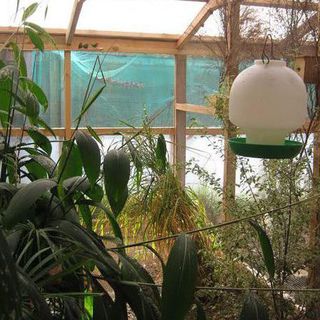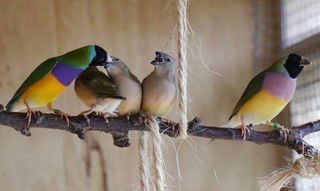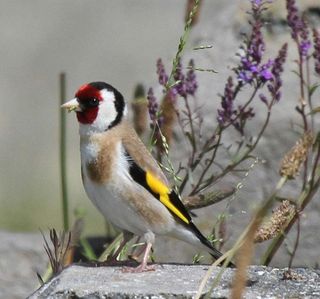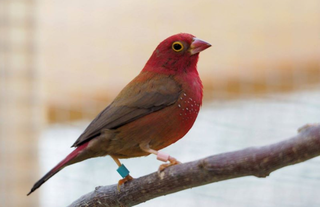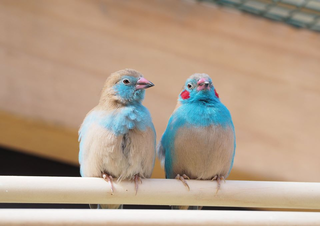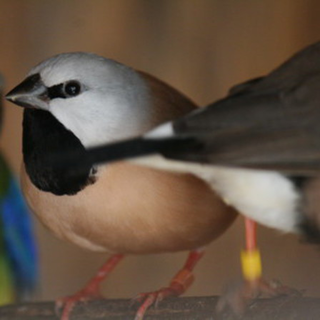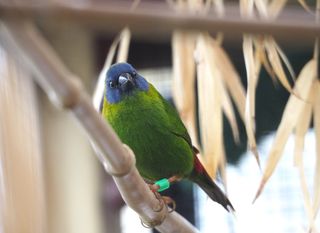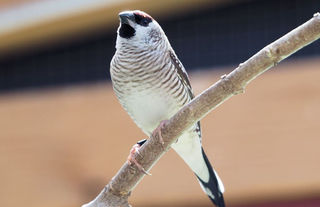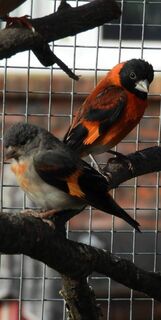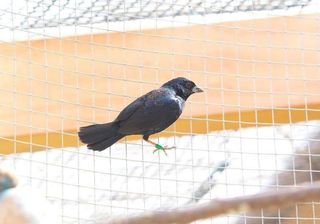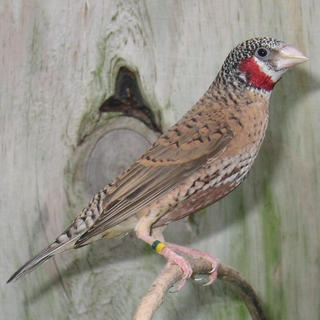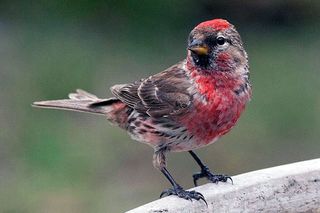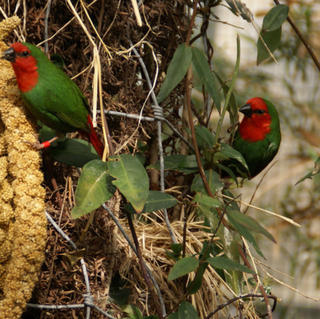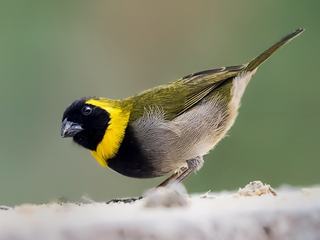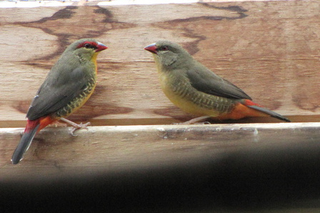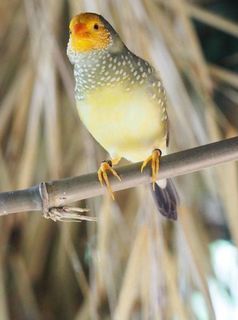Gallery
Click on each photo to enlarge the view, and to show any additional photos (hens or colour variations etc.)
Most of these finches can be purchased, although you may have to place an order with a breeder. Since the last successful import in 1998, many of our finch varieties have declined or been lost to NZ. We hope we can all work together to save the remaining species.
Current price guide is available for members here
-
A selection of ideas from NZFBA members.
-
This Australian finch is one of the most striking members of the bird world. Three different colour head combinations can be found naturally, with the black head form the most common, then red and yellow (orange). Mutations are still relatively uncommon in New Zealand and only the white breasted are available in any number. Gouldians are fairly easy to obtain and will breed well if kept in a draft free aviary or breeding cage. They can be kept with other finches in a mixed aviary.
-
The Goldfinch is frequently seen in the countryside, feasting on flowers and grasses, but not often kept in aviaries though it is possible to get aviary bred birds. Canary breeders sometimes like to cross their birds with Goldfinches to produce 'mules'. Goldfinches are quite sociable, but better mixed with larger birds like Canaries or other British finches, rather than the smaller exotic finches.
-
This African finch is a very popular little bird; it is a good breeder, fairly easy care, easy to sex and eye catching in the aviary. It is recommended as the first exotic finch for novice breeders and it's often available. The Fire Finch is excellent for a mixed aviary. Fires prefer to nest in the lower half of the aviary in a suitable box, basket, or they will build their own nest.
-
This finch comes from the grassy woodlands of central Africa where it is often found on the outskirts of villages. There are different forms but only the red cheeked variety is found in New Zealand. The Cordon Bleu is a very attractive, popular finch which suits a mixed finch aviary. Easy to sex and breed as long as the diet is right with a good finch seed mix with plenty of live food especially maggots, softfood and seeding grasses.
-
Found throughout much of central and southern Africa. The Little Green Singer lives up to its name with a beautiful song although its colouring is more yellow than green. The male is a delight to have in an aviary. It is best to keep one pair per aviary. The female is identified by her necklace of yellow spots which the young also have. Singers often breed over the winter months and like to use hessian, mosses and white cotton wool in their beautiful little nests.
-
The Parson Finch or Blackthroated Grassfinch have black beaks - whereas Longtails, that look very similar otherwise, have red beaks. This Australian finch is found in open savannah. Parsons are now in very short supply in NZ, they mate for life and it is difficult to introduce a new partner - they do better if choosing their own mate. Parsons are best kept as single pairs. The hen is prone to egg binding, esp. when young. In New Zealand a hybrid version of the parson exists which has been created from crossing a Longtail with a Parson. They look very similar except for the beak which is not black. They are not a mutation but a fertile hybrid. Some have grey some have pink beaks
-
This finch comes from Cape York, Australia. Fairly rare now and hard to find. Keep just 1 pair or more than 3 as they can get quite competitive at breeding time when the male can chase the hen around the aviary. Feed requirements: good finch mix with some hulled oats and crushed sunflower. They need green seeding grasses and will enjoy live-food and some fruit as well as soft food when raising young. Do not mix with Red Faced Parrot Finches as they will interbreed.
-
The Plumhead (or Cherry Finch) is a native of eastern Australia where it is usually found in flocks close to water, in reed-beds and in grasslands. This finch was nearly lost to New Zealand but has since made a comeback. Plumheads like to forage on the aviary floor and mix well with other species. Plumheads particularly like seeding grasses and live food.
-
This striking bird comes from the wooded areas of northernmost South America. The Siskin is in limited supply and is a finch for more experienced breeders. It can be a poor parent and needs extra attention, and extra heat for chicks to be successfully raised. Needs a good finch mix with added canary, chia and sunflower seed, green food especially flowering puha. At breeding time they require softfood and live food.
-
Male has a lovely 'Tui' sheen - female intricate and beautiful browns. The Jacarini or Blue Black Grassquit comes from the grasslands of South America. Jacarini are not often seen in New Zealand aviaries, partly because they tend to be quite secretive, hiding in any shrubbery - they like a well planted aviary. Feed requirements: good quality finch mix with the addition of plenty of live food. Jacarini must have a good supply of small mealworms or maggots to breed successfully.
-
Also known as Cutthroats due to their neck colour. Ribbon Finches are easy to sex, and breed well in aviaries or in cages using relatively large nest boxes. The hatchlings can be sexed as soon as they exit the nest, due to the throat markings. They breed best if fed a lot of live food (maggots/mealworms) in addition to the normal seed mixes and soft foods all finches should receive. They are robust birds suitable for beginners.
-
Redpoll species can be found throughout most of North America and Europe. They were introduced into NZ by the early settlers but didn’t colonise the country as successfully as some of the other introduced finches. They have often been kept in aviaries to catch mosquitoes and insects that would otherwise trouble the other aviary occupants. The male redpoll in the wild shows a striking red bib and cap but loses this on the average aviary diet.
-
This boldly coloured finch comes from the forest margins of New Caledonia. It is a very popular finch and is easy to obtain. Red faced parrot finches are excellent for mixed finch collections as they are striking birds, easy care, good breeders and non aggressive so can be kept as a colony also. As they can be very difficult to sex this is sometimes a good option. They must not be kept with other parrot finch varieties as they will interbreed.
-
Cubans are lively inquisitive little finches from Cuba. They have a melodious call, and are easy to breed and easy to sex. Unfortunately, their downside is that they can be aggressive to their own species so it is best to keep only one pair per aviary. Youngsters should be removed from their parents soon after weaning. They mix well with 'non yellow and black' birds! Fast and smart with attitude - definitely pays to have a safety entrance if you keep these little finches.
-
This tiny finch comes from the grasslands of central Africa. The Orange breast is a delightful finch, non aggressive, easy to sex, easy to keep and excellent in a mixed finch aviary. They have become hard to find due to their very short breeding life - hens are as rare as hens teeth almost and can be prone to egg binding. Orange breasts are very happy to be kept as a colony or as a single pair and prefer a well planted aviary.
-
Like several other Australian finches Star Finches tend to be winter breeders, when food is more plentiful. The Red Faced Star Finch is the normal form of this finch, but it is now almost non existent in NZ aviaries! The yellow mutation is more readily available, but not common. The sexes are very similar with the head colour slightly more extensive in the male. Stars can be kept as single pairs or in a colony situation and they are fine in a mixed finch situation.
-
This is a bird very much at home in the paddy fields of its native Java and Bali but it’s a very adaptable finch. The Java finch is quite a large bird and shouldn’t be kept with the smaller finches. It’s fairly hardy and easy to keep and can be housed in a cage or aviary - best kept in flocks/groups. Javas come in quite a number of different mutations including white, fawn and pied.
-
Bengalese finches are available in white, chocolate, fawn, most often in combination with white. There is also a crested form. Bengalese finches are good beginner’s birds, easy care, readily available and fairly inexpensive. They can be used as foster parents for other harder to rear birds. Bengalese finches are very sociable birds. Often called “society finch”. They can be difficult to sex but only the male will sing as he displays and dances to his mate.
-
These Australian finches are very popular little birds, easy to keep and breed, inexpensive, and are a perfect beginner’s bird. They can also provide quite a challenge for skilled aviculturalists with the large range of mutations that can be produced. The normal colour is grey but they can be white, fawn, pied and more! Zebra finches tend to disrupt breeding so best not mixed with delicate exotic finches - happy with Canaries, Java Sparrows and robust finches.


